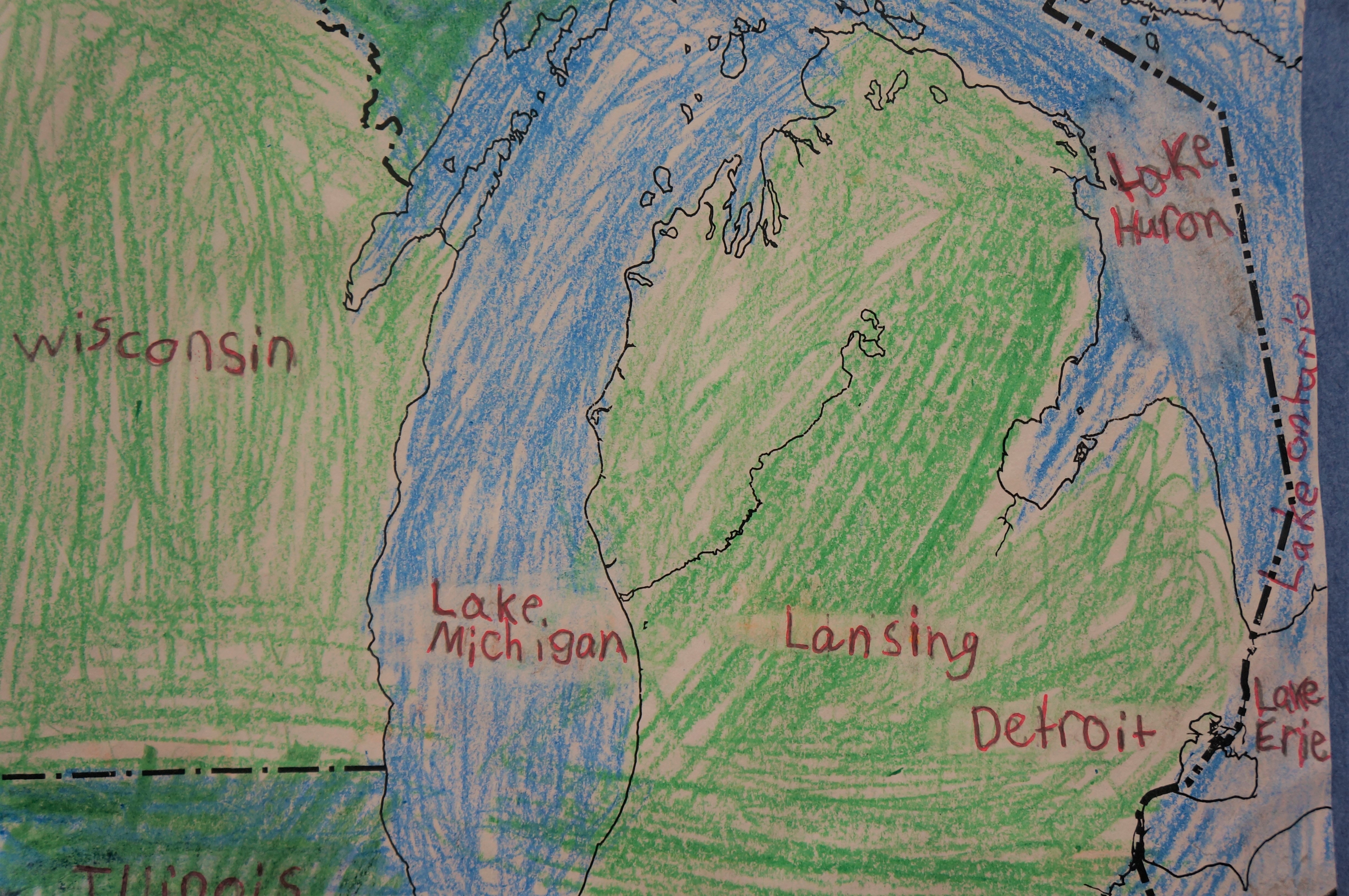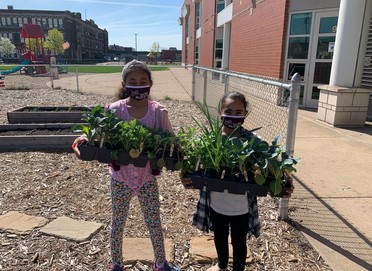When you visit Salina Elementary School in Dearborn, Michigan, one of the first things you are likely to notice is the dynamic student work displayed throughout the school. Colorful art projects hang on the walls and from the ceilings, and student work is posted along every hallway. Classrooms often have intricate science, social studies, or literature projects displayed prominently in the room.
At Salina, a Title I school, more than 90% of students are English language learners (ELLs). Many of the students are newcomers from the war-torn country of Yemen who are arriving with limited formal education. As part of their approach to providing a safe, supportive, and rich learning environment for their young students, Salina has embraced hands-on learning, particularly with newcomers. In this article, the staff share how they have woven hands-on learning across the curriculum and sustained it during COVID-19 and virtual/hybrid learning.
Special thanks to the Salina Elementary educators who contributed to Part 2 of this series:
- Cynthia Alvarado, Media Specialist
- Beth Gorman, Instructional Coach and Garden Supervisor
- Linda Lock, Art Teacher
- Susan Stanley, Salina Elementary Principal
To learn more about Salina Elementary and how the school has engaged with newcomer families during COVID-19, see Part 1 of this series, Supporting Young ELLs' Success During COVID-19.
Hands-On Learning with STEAM
One reason that Salina has enthusiastically embraced hands-on learning is that they have seen the power of giving students early successes while they are learning a new language. They have also seen the opportunities hands-on learning gives students to develop their language skills in both their home languages and in their new language of English.
"STEAM-based activities are integral to closing the equity gap for our EL students," says Principal Susan Stanley. "The power to innovate, create, hypothesize, and collaborate does not require the same level of navigating the nuances of new languages that traditional learning requires. With intentional instruction, language barriers are erased. Children spend time exploring, questioning, and making meaning through discovery and collaborating with their peers. Language development is a natural byproduct of this type of learning."
Salina's activities include building and robotics, makerspace, computer coding, a school garden, and an annual STEAM expo where students show the special projects they have created based on their learning. The staff has looked for creative ways to continue hands-on learning during the pandemic.
Here are some examples of Salina's hands-on activities for students:
- LEGO®: All students participate in LEGO® projects such as problem-solving, model projects in different content areas, and robotics. In addition, Salina Elementary participates in a LEGO® League project to prepare students for the First Robotics program that takes place at Salina Intermediate and Edsel Ford High School. The secondary students serve as mentors for the younger students, which helps them to build a cohesive program. During distance learning, LEGO® League projects were accomplished through family pods since mixed groups were not possible and older siblings mentored younger siblings throughout the process.
- Makerspace: Salina offers a variety of maker projects at each grade level for students to demonstrate their learning in non-linguistic ways. Staff note, "This really offers all students a chance to shine, especially those whose language skills are still developing." Examples of maker projects include: making game boards, models of story elements, and the Grade 3 State of Michigan artifact project. Salina also has a Makers Club after school with a free choice and exploration format. The school had maker kits delivered to homes while students were learning remotely.
- One School One Book: In this project-based program, every student in the school gets the same chapter book and the entire school reads the book together at home and in the classroom. The classes then integrate bulletin boards, displays, reading, writing, making robots (this year they are reading The Wild Robot), art displays, directed drawing, math, and robotics. The staff notes, "Even though we were in the middle of a pandemic and in a hybrid model, the kids read and learned and created with enthusiasm."
Community partnerships
Hands-on learning with ELLs
 The school has had a lot of success using these kinds of activities with newcomer ELLs in recent years, in part because they have seen the power of giving students the chance to feel successful while they are learning a new language. Staff at the school note that they have seen growth in students' language skills, as well as students' ability to demonstrate things they know but do not have enough language to express. These various activities allow students to enhance their oral language, apply vocabulary in real life hands-on settings, and build peer relationships.
The school has had a lot of success using these kinds of activities with newcomer ELLs in recent years, in part because they have seen the power of giving students the chance to feel successful while they are learning a new language. Staff at the school note that they have seen growth in students' language skills, as well as students' ability to demonstrate things they know but do not have enough language to express. These various activities allow students to enhance their oral language, apply vocabulary in real life hands-on settings, and build peer relationships.
Principal Stanley observes, "Students have learned the value of teamwork and effective collaboration. They are able to make observations over time, solve problems as situations occur, and understand that each one of them is an asset to the team and to the project. As they work together, they build healthy relationships where they take risks knowing that they are supported by the staff and by their peers."
Salina increases participation in these activities by encouraging all students to take part in its hands-on extracurricular activities and giving them the support to do so. For example, directions are given in nonlinguistic formats, such as pictures, diagrams, and videos. In addition, Salina staff are always informed about schedules and opportunities for students. They encourage families to become involved with activities and direct their students toward selected activities. Collaboration plays a role too. According to Principal Stanley, "Weekly PLC meetings and planning times allow teachers to coordinate, which the school is able to implement in part because the Dearborn Public Schools district is also committed to the PLC process, which provides opportunities for team collaboration and planning."
Slideshow: STEAM in action at Salina Elementary
The following slides show examples of student projects at Salina on display in the hallways and presented at the annual STEAM expo. These photographs and video stills were taken during the production of our video project, You Are Welcome Here.
Art and English language learners
As noted above, Salina also gives students lots of opportunities for creating art. Art projects are integrated into other content areas and activities such as garden murals, outdoor art, book club collaborations, and Maker Space collaboration. The school has also supported interdisciplinary workshops in Art and Literacy, STEAM, & makerspaces.
Art teacher Linda Lock explains, "Art gives ELLs a place to explore and discover that is engaging and fun. It gives them a place to feel safe, productive, and successful, even with little language. We have many centers available throughout the art studio, from light tables and magnifying glasses to blocks. The students are encouraged to make observations and communicate their ideas by drawing and writing in their sketchbook. They develop fine motor skills as they plan and visualize the steps needed to create their artwork. Being focused on the process of creating as much as on the product helps keep the artistic focus on a growth mindset.
"In the art room all students practice the Studio Habits of Mind. They gain confidence by playing, creating, and discovering with different materials and tools to try and help them express their ideas. Because the room is set up as an art studio, materials and centers are available once basic skills and routines are practiced. This allows the students to build independence in making once they can show (and later describe) the ideas they are planning. Artists create works of art, then reflect on the process by writing artist statements about their work."
The staff also are mindful of embedding language development opportunities in art class. "Scaffolding with pictures, as well as sentence stems and frames, support the young artists in their writing," Ms. Lock writes. "Students often excitedly share the skills and knowledge they learn with each other as they develop a community of creative learners...Being engaged in work you have created can empower and inspire your further learning. This ability to 'see' your ideas concretely enables the young artists' to investigate, describe, and evaluate their process and final artworks."
The Garden at Salina Elementary
 Another success at Salina Elementary is the school garden, started three years ago through a grant with the DSHINES coalition, mentioned above. Additional support came from our parent-teacher-student organization and also a local greenhouse, and the school has funded small projects like new seeds and soil.
Another success at Salina Elementary is the school garden, started three years ago through a grant with the DSHINES coalition, mentioned above. Additional support came from our parent-teacher-student organization and also a local greenhouse, and the school has funded small projects like new seeds and soil.
Students are actively involved in the garden by:
- learning about different fruits and vegetables
- deciding on what will be planted
- preparing the garden beds
- planting seeds
- caring for the beds and weeding
- investigating and observing as the seeds and plants grow
- journaling about the plants and drawing/label everything in the garden.
In addition, children harvest the food and cafeteria workers have served salads and foods from the garden.
Lead teacher Beth Gorman writes, "Last year, the school started a pizza garden where students grew tomatoes and peppers and basil. The garden also has many herbs. The students pick and smell them and discuss how they are used. Mothers of students will often come by and ask for small bags of herbs to take home. The garden also has a pollinator bed and students have learned about pollinators in the garden, using magnifying glasses to observe butterflies, bees, and grasshoppers as well as other insects like ladybugs and beetles. Other activities include 'Eating the Rainbow' and 'What part of the plant do you eat?' The school is also anxiously looking forward to getting an insect house!"
The Salina Garden during COVID-19
This year, the students started seeds indoors early in egg cartons and then transplanted seedlings after 3 weeks. The school purchased beginning plants and added them in the garden. While students were at home, Ms. Gorman made videos of her gardening at home. Students watched videos and journaled with her over the spring and summer, graphing the height of plants every week. She also documented how she cared for the garden during an unexpected April snow storm.
When asked what students are doing now that in-person learning has resumed, Ms. Gorman shares this update: "We are making up for lost time, trying to get small groups in the garden ASAP. Teachers may also take their classes out any day and anytime for investigating, watering, weeding, or even just a read-aloud. Instead of just a bulletin board for sharing, I created a presentation (see below) and shared with the school. That way teachers could share and make sure all students are part of the garden. Pictures are donated and slides added throughout the gardening season. We will continue and expand this through our summer school program."
Slideshow: Salina Elementary Garden
Learn more about the Salina garden from this Google Slides presentation prepared by Ms. Gorman for the Salina community.
Ideas for Other Schools
When it comes to hands-on learning, the staff encourages other schools to start small, just as each of Salina's projects did. At the same time, however, they note that it's important to not create limitations in terms of what's possible. Principal Stanley says, "My best advice would be to begin with brainstorming which activities educators would like to provide their students IF money and time were no object. Starting big, you create the finish line and then whittle down to the point of entry. Anyone can begin something. Once you begin, it will take on a life of its own and opportunities for funding will present themselves. Create the big picture and go from there." She contiunes, "I have never gotten all the funding needed at one time. Some years, some things just aren't possible but I keep telling myself they are just not possible — YET. I tell EVERYONE I know about what's going on at school or projects we are trying to accomplish. Many times support comes from all areas of my life!"
She also urges teachers to advocate for their students. "Teachers are the best voices for their students," she says. "They know what their students need. The research we have now that is based on best practices was started years ago by classroom teachers who didn't settle for the status quo. They knew there had to be better ways to reach their students. These are the kind of grassroot movements which have informed and will continue to inform programming. What teachers need to do is use the power of their voice."
The role of leadership
Principal Stanley also credits the support of the Dearborn Public School district for all of these initiatives. "We could not do this alone," she says. "It is through their vision we have the support of our outstanding building and grounds who support the garden projects not only at Salina but throughout other schools as well. The district supports our schools and the programs they are creating. Our community partners build upon the foundation set by the district."
Principal Stanley can appreciate the difference this support makes because she knows it's not always available. In districts without this support, she says, "The initiatives were difficult to sustain. They either died after an administrator left or were not able to flourish because it was exhausting going it alone. It takes the support of district leadership to create and maintain these initiatives. Without that, it's like rolling having to roll a huge boulder up a hill each day, watch it come down, and doing the same thing the next. Strong district leadership keeps the boulder on top of the hill."
Videos from Dearborn, MI
You can learn more about Salina in our award-winning film You Are Welcome Here, produced in partnership with the American Federation of Teachers. The film includes a section on Salina's hands-on learning activities and STEAM expo, featured below.
You can also see the film with Arabic subtitles, a preview version, and additional videos from Salina in our related resource collection.


